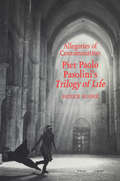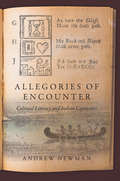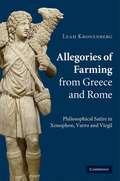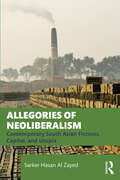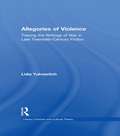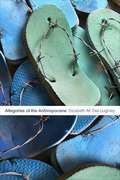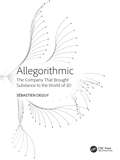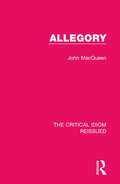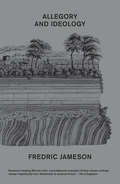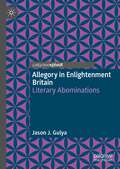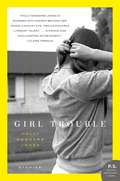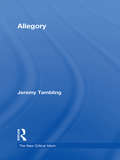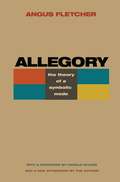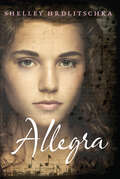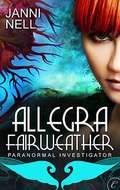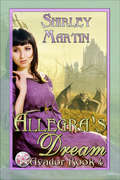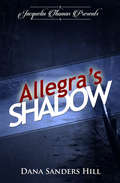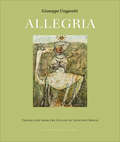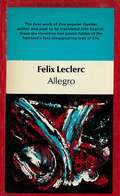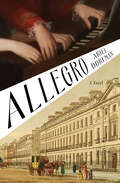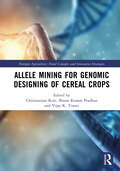- Table View
- List View
Allegories of Contamination
by Patrick RumbleThe Trilogia della vita (Trilogy of Life) is a series of three films that Pier Paolo Pasolini completed before his horrifying assassination in 1975, and it remains among the most controversial of his cinematic works. In Allegories of Contamination Patrick Rumble provides an incisive critical and theoretical study of these films and the Marxist filmmaker's complex, original concept of the cinematic medium.With the three films that make up the Trilogy of Life - The Decameron, Canterbury Tales, and The Arabian Nights - Pasolini attempts to recapture the aura surrounding popular, predominantly oral forms of storytelling through a pro-modern vision of innocent, unalienated bodies and pleasures. In these works Pasolini appears to abandon the explicitly political engagement that marked his earlier works - films that led him to be identified with other radical filmmakers such as Bellocchio, Bertolucci, and Godard. However, Pasolini insisted that these were his 'most ideological films,' and his political engagement translates into a mannerist, anti-classical style or what he called a 'cinema of poetry.' Rumble offers a comparative study based on the concept of 'aesthetic contamination,' which is fundamental to the understanding of Pasolini's poetics. Aesthetic contamination concerns the mediation between different cultures and different historical moments. Through stylistic experimentation, the Trilogy of Life presents a genealogy of visual codes, an interrogation of the subjectivity of narrative cinema. In these films Pasolini celebrates life, and perhaps therein lies their simple heresy.
Allegories of Encounter: Colonial Literacy and Indian Captivities (Published by the Omohundro Institute of Early American History and Culture and the University of North Carolina Press)
by Andrew NewmanPresenting an innovative, interdisciplinary approach to colonial America's best-known literary genre, Andrew Newman analyzes depictions of reading, writing, and recollecting texts in Indian captivity narratives. While histories of literacy and colonialism have emphasized the experiences of Native Americans, as students in missionary schools or as parties to treacherous treaties, captivity narratives reveal what literacy meant to colonists among Indians. Colonial captives treasured the written word in order to distinguish themselves from their Native captors and to affiliate with their distant cultural communities. Their narratives suggest that Indians recognized this value, sometimes with benevolence: repeatedly, they presented colonists with books.In this way and others, Scriptures, saintly lives, and even Shakespeare were introduced into diverse experiences of colonial captivity. What other scholars have understood more simply as textual parallels, Newman argues instead may reflect lived allegories, the identification of one's own unfolding story with the stories of others. In an authoritative, wide-ranging study that encompasses the foundational New England narratives, accounts of martyrdom and cultural conversion in New France and Mohawk country in the 1600s, and narratives set in Cherokee territory and the Great Lakes region during the late eighteenth century, Newman opens up old tales to fresh, thought-provoking interpretations.
Allegories of Farming from Greece and Rome
by Leah KronenbergIn this book Professor Kronenberg shows that Xenophon's Oeconomicus, Varro's De Re Rustica and Virgil's Georgics are not simply works on farming but belong to a tradition of philosophical satire which uses allegory and irony to question the meaning of morality. These works metaphorically connect farming and its related arts to political life; but instead of presenting farming in its traditional guise as a positive symbol, they use it to model the deficiencies of the active life, which in turn is juxtaposed to a preferred contemplative way of life. Although these three texts are not usually treated together, this book convincingly connects them with an original and provocative interpretation of their allegorical use of farming. It also fills an important gap in our understanding of the literary influences on the Georgics by showing that it is shaped not just by its poetic predecessors but by philosophical dialogue.
Allegories of Neoliberalism: Contemporary South Asian Fictions, Capital, and Utopia
by Sarker Hasan ZayedSimultaneously a critique of Foucauldian governmentalist interpretations of neoliberalism and a historical materialist reading of contemporary South Asian fictions, Allegories of Neoliberalism is a probing analysis of literary representations of capitalism’s “forms of appearance.” This book offers critical discussions on the important works of Akhtaruzzaman Elias, Amitav Ghosh, Aravind Adiga, Arundhati Roy, H. M. Naqvi, Mohsin Hamid, Nasreen Jahan, Samrat Upadhyay, and other writers from South Asia and South Asian diaspora. It also advances a re-reading of Karl Marx’s Capital through the themes and tropes of literature—one that looks into literary representations of commoditization, monetization, class exploitation, uneven spatial relationship, financialization, and ecological devastation through the lens of the German revolutionary’s critique of capitalism.
Allegories of Violence: Tracing the Writings of War in Late Twentieth-Century Fiction (Literary Criticism and Cultural Theory)
by Lidia YuknavitchAllegories of Violence demilitarizes the concept of war and asks what would happen if we understood war as discursive via late 20th Century novels of war.
Allegories of the Anthropocene
by Elizabeth M. DeLoughreyIn Allegories of the Anthropocene Elizabeth M. DeLoughrey traces how indigenous and postcolonial peoples in the Caribbean and Pacific Islands grapple with the enormity of colonialism and anthropogenic climate change through art, poetry, and literature. In these works, authors and artists use allegory as a means to understand the multiscalar complexities of the Anthropocene and to critique the violence of capitalism, militarism, and the postcolonial state. DeLoughrey examines the work of a wide range of artists and writers—including poets Kamau Brathwaite and Kathy Jetñil-Kijiner, Dominican installation artist Tony Capellán, and authors Keri Hulme and Erna Brodber—whose work addresses Caribbean plantations, irradiated Pacific atolls, global flows of waste, and allegorical representations of the ocean and the island. In examining how island writers and artists address the experience of finding themselves at the forefront of the existential threat posed by climate change, DeLoughrey demonstrates how the Anthropocene and empire are mutually constitutive and establishes the vital importance of allegorical art and literature in understanding our global environmental crisis.
Allegorithmic: The Company That Brought Substance to the World of 3D
by Sébastien DeguyAllegorithmic: The Company That Brought Substance to the World of 3D explores the journey of Allegorithmic, the software company behind Substance, a suite of tools that revolutionized texturing in computer graphics. This engaging narrative by Sébastien Deguy, the visionary founder and CEO of the company, chronicles the growth of Allegorithmic from its inception as a small startup to becoming a leader in digital content creation, pivotal in shaping the visual aesthetics of video games and films.The book highlights key technological innovations and strategic decisions that propelled the company forward, offering a detailed look at the challenges and triumphs of developing cutting-edge software solutions while building a team attached to its strong values and passion for digital artists.Key Features: Provides a detailed history of Allegorithmic, a company at the forefront of technological innovation in procedural textures and 3D content. Covers significant technical ground, discussing complex environments, procedural textures, and software development, while also delving into the creative aspects of these technologies. Spans the growth of a startup into a major player in the tech industry, providing insights into business strategies, team building, and international expansion. Reflects on the cultural shifts within the company and the broader industry, offering lessons on adapting to technological advancements and market demands. Ideal for tech enthusiasts, artists, and entrepreneurs, this deep book provides a comprehensive overview of the creativity and perseverance required to influence and lead in the tech industry.
Allegorizings
by Jan MorrisNew York Times Book Review • Editors' Choice Jan Morris delivers her final volume, brimming with reminiscences, meditations on daily life, and mini-essays on everything from maturity to whistling to Princess Diana. Not so long ago, feeling intimations of mortality, Jan Morris embarked on a wholly novel literary enterprise. What began as a series of high-minded letters to her late daughter—in the style of Lord Chesterfield addressing his son—quickly transformed itself into a potpourri of mini-essays and vibrant reminiscences, organized around experiences both majestic and mundane, from traveling the world with her lifelong partner, Elizabeth, to sneezing and kissing and simply growing old. So Allegorizings came to be, and so Morris decided that it should only be published upon her death, not because she had anything to hide but, merely, in parting. Featuring essays largely written in the early twenty-first century, Allegorizings reflects, above all, Morris’s steadfast conviction that nothing is only what it seems. In fact, she observes, everything is allegory. Indeed, in Morris’s telling, even life—the whole conundrum of existence—is one long, majestically impenetrable allegory. Taking us from the separatist hippie colony of Bolinas, California, to her home country of Wales, and introducing us to Nepalese Sherpas and elderly cruise-goers alike, Morris follows the throughline of allegory throughout her works. In one essay, she lambasts the joylessness of maturity (“Maturity! Did ever a heart thrill to the sound of it, still less the meaning?”) and in another, decries the nonsense of nationality. With characteristic verve, she offers odes to whistling and cursing, cats, and exclamation points. Morris’s travels anchor the collection, as she revisits the iconic settings of her previous works. We join her aboard the storied Orient Express, as well as tube trains passing through the purlieus of London. So too, we hike the foothills of the Himalayas—where Morris burst onto scene with her on-the-spot reportage of the first ascent of Everest—and reflect on the picaresque allure of Tournus, a dichotomized town in France where one France, bearing all the vestiges of privilege, seems to kiss another. Intimate and luminously wise, Allegorizings is as much a testament to the virtues of embracing life as it is a testament to its charming, indignant, and ever-surprising author. In her final work, Morris’s writing is as erudite as ever, conveying a generosity of spirit “flavored by well-earned crankiness” (Vox). Though newly bereft of her company, readers will be reminded what “a good, wise, and witty companion” (Alexander McCall Smith) Morris has been to so many, for so long.
Allegory (The Critical Idiom Reissued #13)
by John MacQueenFirst published in 1970, this book examines the use of allegory in religious, philosophical and literary texts. It traces the development of the device over time from the Classical period through to the early modern and modern periods, demonstrating its evolution from the transmission of myths and religious beliefs to a literary device.
Allegory Studies: Contemporary Perspectives (Warwick Series in the Humanities)
by Vladimir BrljakAllegory Studies: Contemporary Perspectives collects some of the most compelling current work in allegory studies, by an international team of researchers in a range of disciplines and specializations in the humanities and cognitive sciences. The volume tracks the subject across established disciplinary, cultural, and period-based divides, from its shadowy origins to its uncertain future, and from the rich variety of its cultural and artistic manifestations to its deep cognitive roots. Allegory is everything we already know it to be: a mode of literary and artistic composition, and a religious as well as secular interpretive practice. As the volume attests, however, it is much more than that—much more than a sum of its parts. Collectively, the phenomena we now subsume under this term comprise a dynamic cultural force which has left a deep imprint on our history, whose full impact we are only beginning to comprehend, and which therefore demands precisely such dedicated cross-disciplinary examination as this book seeks to provide.
Allegory and Ideology
by Fredric JamesonFredric Jameson takes on the allegorical formWorks do not have meanings, they soak up meanings: a work is a machine for libidinal investments (including the political kind). It is a process that sorts incommensurabilities and registers contradictions (which is not the same as solving them!) The inevitable and welcome conflict of interpretations - a discursive, ideological struggle - therefore needs to be supplemented by an account of this simultaneous processing of multiple meanings, rather than an abandonment to liberal pluralisms and tolerant (or intolerant) relativisms. This is not a book about "method", but it does propose a dialectic capable of holding together in one breath the heterogeneities that reflect our biological individualities, our submersion in collective history and class struggle, and our alienation to a disembodied new world of information and abstraction. Eschewing the arid secularities of philosophy, Walter Benjamin once recommended the alternative of the rich figurality of an older theology; in that spirit we here return to the antiquated Ptolemaic systems of ancient allegory and its multiple levels (a proposal first sketched out in The Political Unconscious); it is tested against the epic complexities of the overtly allegorical works of Dante, Spenser and the Goethe of Faust II, as well as symphonic form in music, and the structure of the novel, postmodern as well as Third-World: about which a notorious essay on National Allegory is here reprinted with a theoretical commentary; and an allegorical history of emotion is meanwhile rehearsed from its contemporary, geopolitical context.
Allegory in Enlightenment Britain: Literary Abominations
by Jason J. GulyaThis Palgrave Pivot argues for the significance of allegory in Enlightenment writing. While eighteenth-century allegory has often been dismissed as an inadequate form, both in its time and in later scholarship, this short book reveals how Enlightenment writers adapted allegory to the cultural changes of the time. It examines how these writers analyzed earlier allegories with scientific precision and broke up allegory into parts to combine it with other genres. These experimentations in allegory reflected the effects of empiricism, secularization and a modern aesthetic that were transforming Enlightenment culture. Using a broad range of examples – including classics of the genre, eighteenth-century texts and periodicals – this book argues that the eighteenth century helped make allegory the flexible, protean literary form it is today.
Allegory of a Cave
by Holly Goddard JonesIn Girl Trouble, acclaimed writer Holly Goddard Jones examines small-town Southerners aching to be good, even as they live in doubt about what goodness is. A high school basketball coach learns that his star player is pregnant--with his child. A lonely woman reflects on her failed marriage and the single act of violence, years buried, that brought about its destruction. In these eight beautifully written, achingly poignant, and occasionally heartbreaking stories, the fine line between right and wrong, good and bad, love and violence is walked over and over again. In "Good Girl," a depressed widower is forced to decide between the love of a good woman and the love of his own deeply flawed son. In another part of town and another time, thirteen-year-old Ellen, the central figure of "Theory of Realty," is discovering the menaces of being "at that age": too old for the dolls of her girlhood, too young to understand the weaknesses of the adults who surround her. The linked stories "Parts" and "Proof of God" offer distinct but equally correct versions of a brutal crime--one from the perspective of the victim's mother, one from the killer's. Written with extraordinary empathy and maturity, and with the breadth and complexity of a novel, Jones's stories shed light on the darkness of the human condition.
Allegory: Allegory And Literature Of The City (The New Critical Idiom)
by Jeremy TamblingIndispensable to an understanding of Medieval and Renaissance texts and a topic of controversy for the Romantic poets, allegory remains a site for debate and controversy in the twenty-first-century. In this useful guide, Jeremy Tambling: presents a concise history of allegory, providing numerous examples from Medieval forms to the present day considers the relationship between allegory and symbolism analyses the use of allegory in modernist debate and deconstruction, looking at critics such as Walter Benjamin and Paul de Man provides a full glossary of technical terms and suggestions for further reading. Allegory offers an accessible, clear introduction to the history and use of this complex literary device. It is the ideal tool for all those seeking a greater understanding of texts that make use of allegory and of the significance of allegorical thinking to literature.
Allegory: The Theory of a Symbolic Mode
by Angus FletcherAnyone who has ever said one thing and meant another has spoken in the mode of allegory. The allegorical expression of ideas pervades literature, art, music, religion, politics, business, and advertising. But how does allegory really work and how should we understand it? For more than forty years, Angus Fletcher's classic book has provided an answer that is still unsurpassed for its comprehensiveness, brilliance, and eloquence. With a preface by Harold Bloom and a substantial new afterword by the author, this edition reintroduces this essential text to a new generation of students and scholars of literature and art.Allegory puts forward a basic theory of allegory as a symbolic mode, shows how it expresses fundamental emotional and cognitive drives, and relates it to a wide variety of aesthetic devices. Revealing the immense richness of the allegorical tradition, the book demonstrates how allegory works in literature and art, as well as everyday speech, sales pitches, and religious and political appeals.In his new afterword, Fletcher documents the rise of a disturbing new type of allegory--allegory without ideas.
Allegra
by Shelley HrdlitschkaAllegra thinks being at a performing-arts high school will change her life and make her a better dancer. But high school is still high school, complete with cliques, competition and cruelty. Allegra's refuge comes in the form of a class she doesn't want to take—music theory, taught by a very young, very attractive male teacher. Soon all Allegra can think about is music composition—and Mr. Rochelli. But has she misunderstood his attention, or is he really her soul mate?
Allegra Fairweather: Paranormal Investigator
by Janni NellAllegra Fairweather here. Paranormal investigator. Got problems with specters? Shapeshifters? I'm the woman to call. Just don't call me a Ghostbuster. The last guy who did that ended up flat on his back with my boot at his throat. With my 99. 5% success rate, solving the mystery of a bleeding rose that has sprung up on the shores of Loch Furness should have been an easy gig. But already I've heard the shriek of the local banshee, discovered two bodies (and then lost two bodies), and had a near-death encounter with a three-hundred-year-old ghost. And perhaps most dangerous of all, the hot pub owner who hired me now wants to show me exactly what's under his kilt. Luckily, I'm ably assisted by my very own guardian angel. I'm grateful for his help-but he's also drop-dead gorgeous. A bit distracting when I've got a mystery to solve, and the clock is ticking. . .
Allegra's Dream (Avador #4)
by Shirley MartinUsed as a pawn for much of her life, Allegra vows that someday she will determine her own fate. But when Rowan Leinster becomes her guardian, she fears she has gone from bad to worse. ... When a handsome king seeks Allegra's hand in marriage, she must choose between the needs of her country and the desires of her heart.
Allegra's Shadow
by Dana Sanders HillWhen Mariah St. Cloud becomes a full-fledged member of the walking wounded, she shuts down. She’s learned that men are born heartbreakers, so the biology professor makes work her lover instead. It’s dependable and won’t leave the toilet seat up. But the untimely death of her beautiful, estranged sister Allegra kicks Mariah’s predictable life to the curb, and brings ex-cop Anthony Caine into her everyday existence – intense, protective and far too handsome for her self-imposed celibacy. Conflict is inevitable. Anthony wants to tumble Mariah’s reserve like the walls of Jericho and keep her safe. Mariah just wants him out of her hair – even as she stands in the deadly shadow of Allegra’s secrets.
Allegria
by Giuseppe UngarettiGeoffrey Brock, whose translations have won him Poetry magazine's John Frederick Nims Memorial Prize and a Guggenheim Fellowship, finally does justice to these slim, concentrated verses in his English translation, alongside Ungaretti's Italian originals.Famed for his brevity, Giuseppe Ungaretti's early poems swing nimbly from the coarse matter of tram wires, alleyways, quails in bushes, and hotel landladies to the mystic shiver of pure abstraction. These are the kinds of poems that, through their numinous clarity and shifting intimations, can make a poetry-lover of the most stone-faced non-believer. Ungaretti won multiple prizes for his poetry, including the 1970 Neustadt International Prize for Literature. He was a major proponent of the Hermetic style, which proposed a poetry in which the sounds of words were of equal import to their meanings. This auditory awareness echoes through Brock's hair-raising translations, where a man holding vigil with his dead, open-mouthed comrade, says, "I have never felt / so fastened / to life."
Allegro
by Adora BennettThe only African American vice president at one of Boston's hottest ad agencies, Jada Green is at the top of her game. She's 45 and single, but she's living life to the fullest. Luca Alessandri, the strikingly handsome president of Allegro, an Italian commercial design firm, is looking for an ad agency to help craft his company's image in the US. When they meet, they are both thrown off balance by their instant attraction. Jada knows there can only be trouble getting involved with a potential client, so she faces a real dilemma when Luca starts pursuing her with a vengeance. Their romance takes them from Boston to the Alpine beauty of Torino, Italy and back again as they learn about each other and struggle to balance their careers, friendships, jealousies ...and threats from vengeful colleagues.
Allegro
by Adora BennettThe only African American vice president at one of Boston's hottest ad agencies, Jada Green is at the top of her game. She's 45 and single, but she's living life to the fullest.Luca Alessandri, the strikingly handsome president of Allegro, an Italian commercial design firm, is looking for an ad agency to help craft his company's image in the US. When they meet, they are both thrown off balance by their instant attraction.Jada knows there can only be trouble getting involved with a potential client, so she faces a real dilemma when Luca starts pursuing her with a vengeance.Their romance takes them from Boston to the Alpine beauty of Torino, Italy and back again as they learn about each other and struggle to balance their careers, friendships, jealousies ...and threats from vengeful colleagues.
Allegro: A Novel
by Ariel DorfmanThis thrilling historical mystery starring Mozart tells of friendship and betrayal, and how music allows us to defy death—from the acclaimed author of Death and the Maiden and The Suicide Museum.In 1789 Wolfgang Amadeus Mozart visits the grave of Johann Sebastian Bach in Leipzig, looking for a sign, a signal, an answer to an enigma that has haunted him since childhood: Was Bach murdered by a famous oculist? And years later, was Handel a victim of the same doctor?Allegro follows his investigation, from the salons of London to the streets of Paris, recreating an enthralling and turbulent time, full of rogues and brilliant composers, charlatans and presumptuous nobles. Running parallel to this search is the rise of Mozart, his knowledge and fame, his trials and losses.
Allele Mining for Genomic Designing of Cereal Crops (Nextgen Agriculture)
by Chittaranjan Kole Sharat Kumar Pradhan Vijay K TiwariThis book deliberates on the concept, strategies, tools, and techniques of allele mining in cereal crops and its application potential in genome elucidation and improvement, including studying allele evolution, discovery of superior alleles, discerning new haplotypes, assessment of intra- and interspecific similarity, and studies of gene expression and gene prediction. Available gene pools in global germplasm collections specifically consisting of wild allied species and local landraces for almost all major crops have facilitated allele mining. Development of advanced genomic techniques including PCR-based allele priming and Eco-TILLING-based allele mining are being widely used now for mining superior alleles. Allele's discovery has become more relevant now for employing molecular breeding to develop designed crop varieties matching consumer needs and with genome plasticity to adapt the climate change scenarios. All these concepts and strategies along with precise success stories are presented in the chapters dedicated to the major cereal crops. The first book on the novel strategy of allele mining in cereal crops for precise breeding Presents genomic strategies for mining superior alleles underlying agronomic traits from genomic resources Depicts case studies of PCR-based allele priming and Eco-Tilling-based allele mining Elaborates on gene discovery and gene prediction in major cereal crops This book will be useful to the students and faculties in various plant science disciplines including genetics, genomics, molecular breeding, agronomy, and bioinformatics; the scientists in seed industries; and the policymakers and funding agencies interested in crop improvement.
